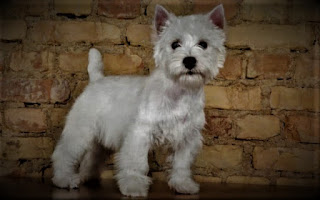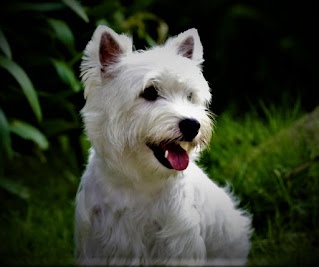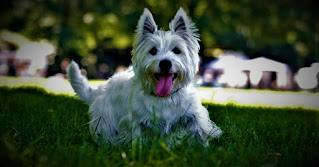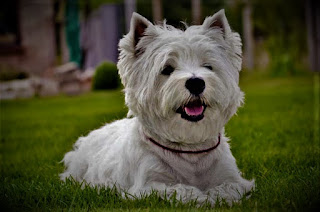West Highland White Terrier
history
The West Highland White Terrier was born in Scotland - the
inhabitants of this beautiful mountain country valued these small dogs first,
for their ability to catch rats, badgers, foxes, and otters, and secondly - for
their cheerful, cheerful temper. Catching rodents in barns and pantries was a
very important business, as the quality and quantity of food, depended on the
life of the family in winter. The West Highland White Terrier has the same
roots as the dandy dinmont terrier, Sky Terrier, Scotch Terrier, and Cairn
Terriers - all of them are considered different branches of the same
breed.
The earliest evidence of the appearance of the West Highland
White Terrier dates back to the 16th century when James I of the Scrimjour
clan gave one such dog to the King of France. Moreover, in those distant times,
the breed did not have a pure white color of wool, and dogs could be of
different shades. However, there is a legend that tells why all colors
remained only white.
One day, Colonel Malcolm from the town of Poltalloch hunted
and saw a fox hiding behind a pyramid of stones. He shot and killed the animal.
However, coming closer the colonel saw that it was not a fox, and his dog -
since then, the West Highland Terrier also acquired the word white (white) in
the name of the breed.
Colonel Malcolm, being an enthusiastic breeder and an
influential man, set about eradicating other breeds so that such cases could
not happen in principle. After all, a snow-white dog can not be confused with a
fox or a badger. The West Highland White Terrier was recognized by England
Kennel Club under its current name in 1906. He was also formerly known as the
Poltalloch Terrier and the Pink Terrier.
Characteristics
of the breed
popularity 08/10
training 05/10
size 02/10
mind 05/10
protection 10/10
Relationships with children 10/10
Dexterity 06/10
Breed information
|
country |
Scotland |
|
lifetime |
12-16 years old |
|
height |
Males: 34-41 |
|
weight |
Males: 7-10 |
|
Longwool |
Short |
|
Color |
White |
price |
600 - 2000 $ |
description
West Highland White Terrier - these are small dogs, with a
strong physique, and sometimes can be prone to excess weight. The head is round,
the muzzle is short, with a lush mustache, and the ears are standing triangular,
small. The limbs are medium, and the tail is medium. The wool is wavy and white.
personality
The West Highland White Terrier is a very funny, fun, and
cheerful breed. They are also called abbreviated and affectionate - dog
"lead." These dogs are always happy to play, they like to fool around
and have fun, and they do not need company. The animal may well find occupation on its own, if he will have a toy, a stick, a plastic bottle - in
principle, it does not matter what. Even soft toys are quite suitable.
Therefore, it is better to put soft toys in such a place
that the dog did not get to them. Better yet, to highlight a few soft toys, and
be prepared for the fact that it will tear them apart with a happy look -
affects the hunting past. Breed lead loves walks and has a lot of energy, so
you need to pay attention to active games.
This little terrier can be very opinionated, despite its
modest size being bold and having your own opinion regarding your wishes or
commands. His playful temper can sometimes be snooty when it comes to other
dogs on the walk or people he for some reason did not like.
In order to make the character more harmonious, it requires
proper education and early socialization, as well as most other breeds of dogs.
Basically, bullying towards other dogs manifests itself as same-sex aggression,
but with strangers' negative attitudes - a rare phenomenon, but possible. If they
are friends of the family who came to visit you, most likely the dog will try
to make friends with them, will be positive, and will try to play.
The breed of West Highland White Terrier is good for
children, in large part because it sees them as like-minded in terms of games.
These dogs are always happy to play and generally have fun and will go with
you to the end of the world, curiously learning all around. They are delighted
with the adventures, new places, people, walking in the park, or going to visit.
Members of their family are affectionate, but sometimes their self-confidence
can be a problem. For example, when a dog at all costs wants to sleep with you
in the same bed, and can not even imagine that you - against.
teaching
Training can be difficult because of the assertive,
self-confident nature of the dog. Especially causes them stubbornness and
desire to fight abuse, injustice, and boring, monotonous, long occupations,
when the owner himself does not show flexibility and does not know how to find
an approach to the animal.
That is, you have to be a consistent and assertive owner who
knows what he wants and knows how to achieve his, but at the same time maintain adequacy, not be nervous, and have patience. In addition, you can
not do without a sense of humor with this breed. They need to train basic
teams, focus on cancellation commands, and constantly monitor behavior to form
the right character and thereby rid themselves of a lot of unnecessary
problems.
As we have said above, first of all, you will need to fight
with self-confidence and sometimes even too brazen character. Classes do not
need to do too long, alternate them with game tasks in which you can weave
commands.
care
The West Highland White Terrier is a breed of dog with wavy
hair that will require you to comb 3 times a week. And maybe haircuts. These
animals need not only be calculated but also combed, disassembling the tangled
areas with your fingers. Bathing a dog is required at least once a week, but it
is better more often, as most likely it will have close contact with you and
your children, and perhaps even sleep in the same bed. The claws are trimmed 3
times a month, the eyes are cleaned daily, and the ears - 3 times a week.
Common diseases
Breed lead has health problems, although, do not think that
buying a dog, all these sores will fall like snow on your head - not at all.
But some of them, indeed, can manifest themselves:
- craniomandibular osteopathy;
- Legg-Calve-Perthes disease (Legg Calve Of Perth);
- cataract;
- pulmonary fibrosis: This disease is also known as "lung disease to lead." This disease leads to scarring on the supporting tissue in the air sacs and connective tissue of the lungs. Further, the lungs lose elasticity, which prevents the normal flow of oxygen into the blood.
- Symptoms: may include loss of stamina, rapid breathing, crackling in the lungs, dry cough, shortness of breath, and shortness of breath. They manifest differently in different dogs, and many individuals do not show the disease for many years. Pulmonary fibrosis can lead to heart failure and other diseases.
- Prevention: there is no cure today, and the prognosis is always negative, so prevention is crucial. Preventing any respiratory infections, limiting exercise, and maintaining a healthy weight (or weight loss for overweight dogs) are key. The disease is sometimes treated, by keeping cool in the house and using bronchial extenders. Treatment is more successful if the disease is diagnosed at an early stage before the scars get out of control;
- knee dislocation - also known as compressed knee joints;
- hip dysplasia - this breed is not very common.

.jpg)






.jpg)


0 Comments